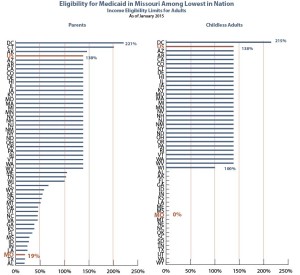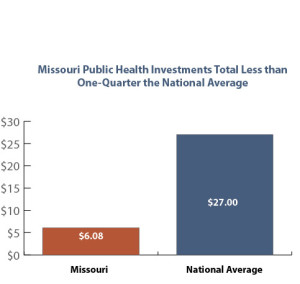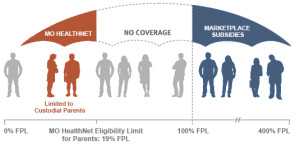Last week, MBP highlighted where our state has been over the past decades, and how our investments in education have diminished in value over time. Today, we examine the health of our state and the implications for our future.
A healthy Missouri is a fundamental building block of a prosperous economy and a good quality of life. A healthy Missouri is one where:
- All Missouri families can get the health care they need, so students and employees are healthy for work and school.
- Sickness or chronic illnesses are caught early, rather than waiting for an emergency to hit.
- A strong public health infrastructure encourages wellness and reduces communicable disease.
Access to Health Care
One in nine Missourians is uninsured, yet Missouri’s eligibility for Medicaid is third-lowest in the nation. In 2005, Missouri made dramatic cuts to its Medicaid program, causing 100,000 Missourians to lose their health care coverage. The cuts to eligibility remain today. As a result, parents in a family of three that earn more than $301 a month are not eligible for Medicaid in Missouri.
While Missouri’s uninsured rate dropped about 25 percent over the last two years, other states have experienced much higher declines in their uninsured rates over the same period. Nationwide, the decline in the uninsured is largely attributable to two provisions within the federal Affordable Care Act, including implementation of Medicaid expansion and state health exchanges.
States that implemented both measures averaged drops of 44 percent in the number of uninsured in their state. Passing Medicaid expansion in Missouri would close a gap in overage for about 300,000 Missourians, improving the reliability of employees for businesses, and providing a net savings of about $100 million in state general revenue annually for the state.
Behavioral Health Care Weakening
Although one in ten Missouri adults have a serious mental illness, 40 percent of those go without treatment.
Yet Missouri cut state general revenue funding for mental health services by as much as 35 percent since 2009.
Missouri’s spending on public mental health services at $99.40 per capita is well below the national average of $119.62 per capita.
Reimbursement rates for the Department of Mental Health’s community providers have fallen far behind inflation, making it harder for providers to maintain proper staffing and services.
If left untreated, serious mental illness can escalate and result in premature death, increased incarcerations, create burdens to county jails and law enforcement agencies, and increased costs for Missouri taxpayers.
Public Health
Missouri ranks 50th in the nation in the amount of funding it provides to public health. And the public health infrastructure is what we rely on to monitor and detect disease outbreaks.
Missouri spends less than one-fourth the amount that most other states spend on public health services. Missouri spends just $6.08 per person in state funding for public health, while the national median amount is $27.40.
In 1990, Missouri was ranked as the 24th healthiest state, but by 2014 Missouri dropped to 36th in the nation.
Investments in local public health agencies have been cut by nearly two-thirds since 2001.
Missouri must do better to invest in the health of its people. Tomorrow we’ll present ways that the Governor and Legislature can, in the 2016 legislative session, begin laying the foundation for a more prosperous Missouri future.


